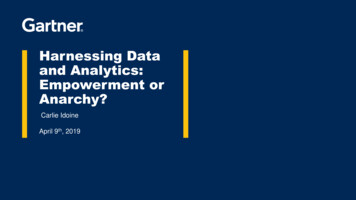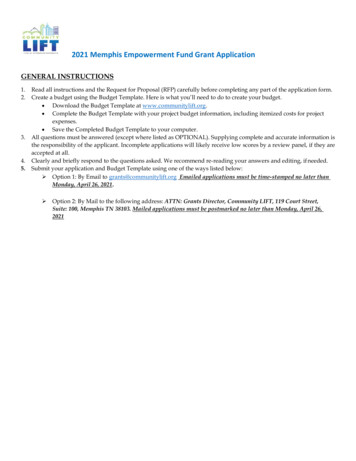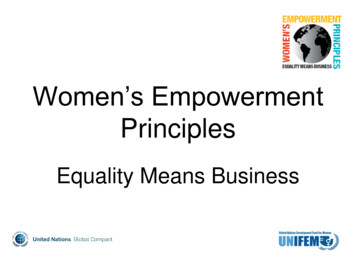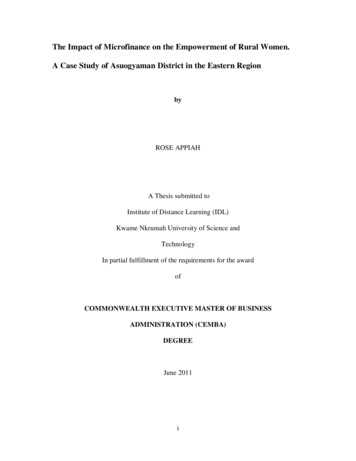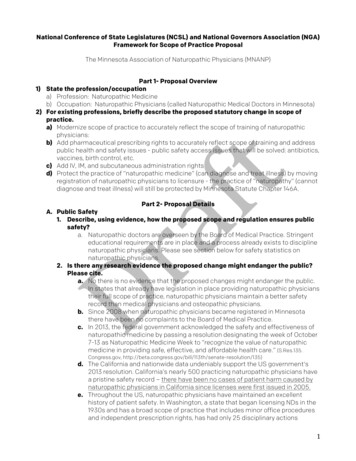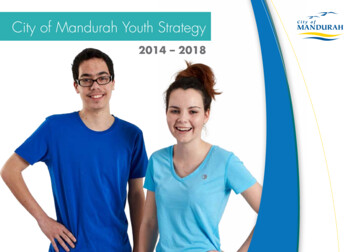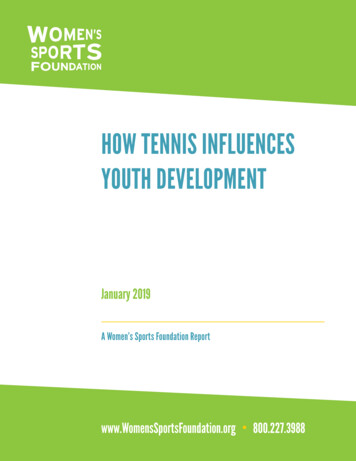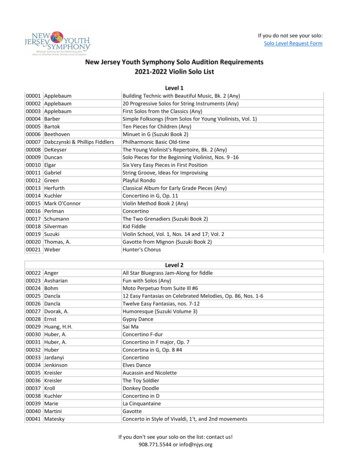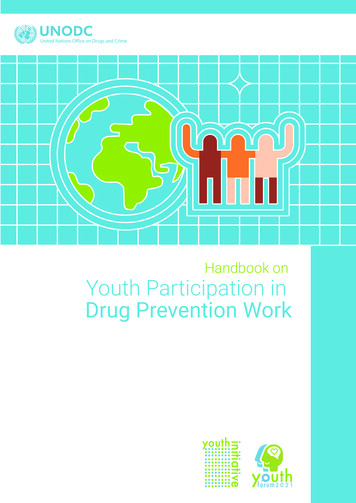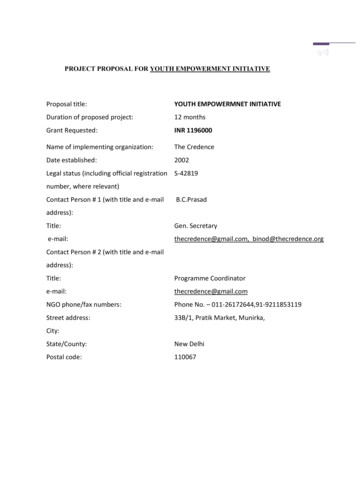
Transcription
PROJECT PROPOSAL FOR YOUTH EMPOWERMENT INITIATIVEProposal title:YOUTH EMPOWERMNET INITIATIVEDuration of proposed project:12 monthsGrant Requested:INR 1196000Name of implementing organization:The CredenceDate established:2002Legal status (including official registration S-42819number, where relevant)Contact Person # 1 (with title and e-mailB.C.Prasadaddress):Title:Gen. Secretarye-mail:thecredence@gmail.com, binod@thecredence.orgContact Person # 2 (with title and e-mailaddress):Title:Programme Coordinatore-mail:thecredence@gmail.comNGO phone/fax numbers:Phone No. – 011-26172644,91-9211853119Street address:33B/1, Pratik Market, Munirka,City:State/County:New DelhiPostal code:110067
TABLE OF CONTENTSTitlePage No.1. Introduction 32. Executive summary 53. Justification of project proposal .64. Background of the organization .95. Target group 136. Goals, objectives and outcomes of the project 147. Project monitoring and evaluation .178. Sustainability of the project .18.9. Requirement of human resource for the project 1810. Budget .19.11. Annexures .
1. INTRODUCTIONIn 1995, the world youth population—defined by the United Nations as the age cohort 1524—is estimated to be 1.03 billion, or 18 per cent of the total world population. As per the2001 Census of India, population age 15-24 years accounts for 195 million of the 1,029million of India‘s population. In other words, every fifth person in India belongs to the agegroup 15-24 years. This population, which is the focus of this proposal, is identified by theUnited Nations Population Fund (United Nations, 2009) as youth or the youth population.By 2011, this age group is expected to grow to 240 million (Office of the Registrar General,2006) and account for a slightly higher proportion of the total population than in 2001.Definitions of youth have changed continuously in response to fluctuating political,economic and sociocultural circumstances. Young people in industrialized countriescomprise a relatively smaller proportion of the total population because of generally lowerbirth rates and longer life expectancy. They comprise a social group that faces particularproblems and uncertainties regarding its future, problems that relate in part to limitedopportunities for appropriate employment. Many developing countries are alsoexperiencing unprecedented rates of rural-urban migration by young people. The difficultcircumstances that people experience in many developing countries are often even moredifficult for young people because of limited opportunities for education and training,viable employment and health and social services, and because of a growing incidence ofsubstance abuse and juvenile delinquency. Their imagination, ideals, considerable energiesand vision are essential for the continuing development of the societies in which they live.Thus, there is special need for new impetus to be given to the design and implementation ofyouth policies and programmes at all levels. The ways in which the challenges andpotentials of young people are addressed by policy will influence current social andeconomic conditions and the well-being and livelihood of future generations. In 1965, in
resolution 2037 (XX), the General Assembly endorsed the Declaration on the Promotionamong Youth of the Ideals of Peace, Mutual Respect and Understanding between Peoples.From 1965 to 1975, both the General Assembly and the Economic and Social Councilemphasized three basic themes in the field of youth: participation, development and peace.Young people in all parts of the world, living in countries at different stages of developmentand in different socio-economic settings, aspire to full participation in the life of society.Young people represent agents, beneficiaries and victims of major societal changes and aregenerally confronted by a paradox: to seek to be integrated into an existing order or to serveas a force to transform that order.
2. EXECUTIVE SUMMARYIn today’s world the youth is facing the most of hardships and lack of belongingness withinthe society. Youth in India constitute a big chunk of the population, yet it remains the mostsubjugated and marginalized. The difficult circumstances that young people face because oflimited opportunities for education and training, viable employment and health and socialservices, and because of a growing incidence of substance abuse and juvenile delinquency isdeteriorating the chance of India’s quest for achieving the status of a developed Nation.Their imagination, ideals, considerable energies and vision are essential for the continuingdevelopment of the societies in which they live.The organization here is focussing on the most underprivileged youth residing in urbanslums, surviving on meagre of resources and constantly seeking out a purpose for their life.The organization plans to work with the youth who never have been nurtured and rearedin a way to develop into a productive generation, because of which the petty crimes in thecommunity is constantly on rise. The delinquency amongst them is not detrimental for theyouth only but the whole urban slum society is on the verge of eruption, as they had nomeans to devise a solution for the same.The Credence has the past record of working with the youth for their development andinclusive growth and in continuation of that only it proposes to obtain the resources for theYouth Empowerment Initiative, which has the potential of integrating the values of a goodand productive citizen in youth, motivating them to lead a normal life by providing them aplatform to develop and showcase their skills. The project proposes to select 50 mostmarginalized and vulnerable group of youth within the slum of R.K. Puram and developthem into a productive and empowerment citizen. The proposal will need resources
amounting to Rs. 11, 96, 00, which taking into consideration the purpose it will serve forthe society is a justified amount.3. JUSTIFICATION OF PROJECT PORPOSALa) . STATEMENT OF THE PROBLEMThe urban slums in India are facing a transforming phase when the second generation ofthe migrants are finding about solutions, measures to improve their situation and DEstigmatize themselves.The emergence of urban slums in Delhi started during 1960-70s, the time when theindustrialization processes was rapidly increasing the demand of manual labour. Thepeople migrated to cities had no legal status and were the most subjugated group in thesociety. They had very less of resource to survive upon with no measures by the govt.towards the acknowledgement of their existence in the cities. The generation succeeding thefirst migrants had a very tough time settling in such environment where every provision ofthe social justice was trampled upon by the society. They were deprived of even the mostbasic of the amenities such as education, health, safe drinking water and employment. Thelack of these provisions gave rise to severely delinquent youth who were suffering at thehands of the negligent community and government.The marginalized second generation of the people settled in the community (youthmembers) are facing a plethora of problems which are: Inequities in social, economic and political conditions, including racism andxenophobia, which lead to increasing hunger, deterioration in living conditions and
poverty among youth and to their marginalization as refugees, displaced persons andmigrants; Continuing discrimination against young women and men and insufficient access forthem to equal opportunities in employment and education; High levels of youth unemployment, including long-term unemployment; Increasing incidence of diseases, such as malaria, the human immunodeficiency virusand the acquired immunodeficiency syndrome (HIV/AIDS), and other threats to health,such as substance abuse and psychotropic substance addiction, smoking and alcoholism; Inadequate opportunities for vocational education and training, especially for personswith disabilities; Changes in the role of the family as a vehicle for shared responsibility and socializationof youth; Lack of opportunity for young people to participate in the life of society and contributeto its development and well-being; Prevalence of debilitating disease, hunger and malnutrition that engulfs the life of manyyoung people; Increasing difficulty for young people to receive family life education as a basis forforming healthy families that foster sharing of responsibilities ; and Continuing deterioration of the global environment resulting from unsustainablepatterns of consumption and production, particularly in urban societies, which is amatter of grave concern, aggravating poverty and imbalances;b) PRIORITY NEEDSAfter consulting with the community members and various other stakeholders the priorityneed of the youth is the inculcation of social values and norms of the society. Organizationhad several sessions with the community members to decide the reasons behind youth
members of their community taking the illegal and non-productive way to leading theirlife. The elders lamented the lack of efforts and time given by them towards rearing theirchildren, unaccepted social behaviour by community elders in presence of youth, easyavailability of drugs, alcohol, opportunities for flesh trade and their negative socioeconomic status etc.c) The proposed approachThe proposed approach decided mutually by implementing agency, community membersand other stakeholders are:I.Inculcation of social values in youth.II.Exposure to developed and proper way of living in and outside the community.III.De stigmatizing them in Police peripherals, for the maligned status of youth givesample opportunity to police to be always suspicious of them.IV.Providing vocational skills to youths in trades with established market demand.d) The implementing organization“The Credence” is dedicatedly working towards empowering the youth in the urban slumssince the very first day of its inception in 2002, through several measures such asvocational training, (1200 youths trained), coaching, counselling and by several othermeasures. The organization has the expertise of relating with the youth and workingtowards their holistic empowerment with ample participation from all the stakeholders.Organization has the distinctive know how of making youth participate in our programmesand avail all of our services.Some of the successful programmes successfully concluded till now are:S.No.Nameofthe Started in the No.Programmeyearof CurrentbeneficiariesstatusFunded by1.Vocational training 2008400TerminatedONGC2.Academic coaching 2008740TerminatedONGC(basic computers)and remedial classes
3.Beauty culture201040On-goingDelhi Govt.4.Sewing and Knitting201040On-goingDelhi Govt.5.Youth participation 2008for awareness forMore2000than On-goingclimate changeGlobalclimatecampaignThe need for a holistic measure to work with those who are extremely marginalized andsubjugated was always felt by the organization and in continuation of our efforts we areproposing the proposal which seeks to counter the maligning status of the youth in severelyunder developed slum of R.K. Puram area of South West Delhi and provide them with ampleopportunities to decide the course of their life.4. BACKGROUND OF THE ORGANIZATION “THE CREDENCE”a) Establishment‘The Credence’ registered in 2002 is an all India Character organization, dedicated toimparting knowledge, skills and awareness amongst the poorest strata of the society withemphasis on employment generation, looking after destitute, empowering women, waterharvesting, preventing AIDS and other health hazards, drug de-addiction, witnessprotection and awareness about environment and hygiene.b) GovernanceThe organization has a General Assembly consisting of founding members and othermembers who have joined the association after its establishment to oversee and deal with allpolicy issues. It has also a managing board of eleven members to decide on majoradministrative matters and oversee major developments and guide its operations. There is a
management committee consisting department heads and chaired by General Secretary todeal and execute day-to-day administrative and managerial matters.The General Secretary, responsible to the Board of directors, is entrusted with the main taskof overseeingand implementing decisions passed by the General Body and Board ofDirectors. He also manages the day-to-day activities and operations of the organization.The organization has four major departments, namely Administration, Finance, Programand Public Relations departments, and each department has also three to five sections.c) Vision, Mission and Objective of the OrganizationVisionTo see a health, gender balanced, prosperous and productive society that lives in aconducive environment.MissionThe organization envisions to provide the skill & knowledge to the under privilege Strata ofthe society so that they can recognize and use the resources around them for their holisticempowerment.General ObjectiveTo identify, tap and optimally harness the potential of the under-privileged classes of thesociety in such a way as to strike a judicious balance between their own quality of life aswell as towards their meaningful contribution to the society/nation.
d) Activities of the Organization LEARNING CENTER:Learning Centre was established in the year 2002 for educating the children of the weakersections belonging to the under Privileged class of Dr Ambedkar Nagar especially for schooldrop-out and child labour. It has strength of 250 regular students and 09 staff. Thechildren are trained for 6 month to one year in the learning centre and they are admitted tothe nearby Government and private sector. ORGANIZING SHGs:‘The Credence’ undertakes special efforts to motivate people particularly fromsocioeconomically weaker sections and those living in slums, tribal, rural areas, for selfemployment. The information regarding major role of women in economic empowermentof community is disseminated to the people, which make formation of SHGs possible inhighly marginalized areas.Organization has till now formed 12 SHGs, which are dedicatedly working towardsresurrection of their social as well as economic status, resulting into acknowledgement oftheir role in community and improvement of living status. VOCATIONAL TRAINING:The Credence provides vocational training (cutting, tailoring and computer literacy) to thewomen and youth of Dr. Ambedkar nagar, Dakshinpuri, Subash Camp, Sanjay Camp, SouthDelhi, Slums of R.K.puram, and South-West Delhi and in Madhubani, Bihar. Organizationhas trained more than 1200 youth in vocational training and remedial classes wherein,most of the beneficiaries are successfully placed in satisfactory jobs.
GENDER RESOURCE CENTER:Also known as Samajik Suvidha sangam Kendra is a pilot project of Delhi Govt. where theorganization is entrusted with the responsibility to function as the single window clearancecentre for all the 47 welfare schemes of Delhi Govt. and several others of Central govt. CAREER GUIDANCE:“The Credence’ regularly holds career guidance by experts from relevant fields in govt.school and community and makes special efforts to spend awareness for self-employmentoriented vocational education and motivates youth as well as their parents to providesupport to the youth in their efforts. DRUG AWARENESS CAMP:“The Credence’ organizes camps in slum areas and locales inhabited by socially andfinancially disadvantaged strata not only for disseminating awareness about harmful effectsof Drugs but also spread knowledge about methods for de-addiction. Until now, more thantwenty six individuals in Subhash Camp, Sanjay Camp have benefited from the deaddiction drive launched by ‘The Credence’ in year 2010-2011.The drug awareness campsare one of the basic components of our role in community development. Legal Aid Camp:‘The Credence’ organized legal aid camps at Subhash Camp, Dr.Ambedkar Nagar,R.K.Puram ,New Delhi and other places for making available legal aid particularly towomen and people from Scheduled Castes and Scheduled Tribes Disability Camp:-‘The Credence’ not only spreads information and awareness among disabled/handicappedpeople about various beneficial schemes enunciated for them but it also makes concreteefforts to enable them to benefits from such schemes, financially and medically. As a resultof these efforts by ‘The Credence’ fourteen physically disabled people were able to begin
self- employment and four disabled people were treated successful surgical operations inspecial disability hospital of Sahibabad in the year to 2009-2010. Environment Camps:‘The Credence’ organizes camps in Sanjay Camp, Subhash Camp, Dakshinuri, R.K.puram togenerate awareness and motivation regarding environments, de- pollution, plantation oftrees, cleanness etc. These camps were fairly successful and made a tangible and lastingpositive impact on the ecology of these areas. Health check-up camps:Organization in partnership with Max health care is regularly organizing health check-upcamps in the slums of R.K.Puram and Dr. Ambedkar Nagar and provides prescribedmedicines for free of cost.5. TARGET GROUPa. Direct Target GroupThe youth of community would be the direct target group. It will mainly involve the youthswho are perceived to be as the burden and non-productive members for the society. Thevulnerability of the youth will be judged by the extent of his relevance in the society as wellas the interest shown by him/her towards the “Youth Empowerment Initiative” Project. Theorganization will select 50 most vulnerable youth members of the community from whichit expects at least 30 members to complete the project successfully.b. Intermediate Target GroupsIt will include Teachers and retired teachers, Parents of youth, Employers of youth(if any),Local People’s representatives, Bureaucrats, Local opinion leaders, Delhi Police, MediaWorkers, Civil Society Organizations, Local community directly concerned with behaviourproblems of youth.
6. GOALS, OBJECTIVES AND OUTCOMES OF THE PROJECTLogical frameworkGOALOUTCOMESACTIVITIESOUTPUTSTIME FRAMERISKS(The overall, long-(Immediate(Activities that will be(The specific(When each(The potentialterm developmentoutcomes for theimplemented to reachoutputs that eachactivity will beproblems that must begoal towards whichproject.)each outcome.)activity willimplemented)overcome for eachthe project willdeliver.)activity to finish oncontribute.)time.)The project seeks to1). The developed1.1, Develop a youthFormation of a1st to 4thIrregularity ofinculcate the socialsense ofgroup through variousclose group readymonthparticipation innorms and values inresponsibility andmeasures, e.g. groupto participate inprogrammes,delinquentvolunteerismwork, screening ofwelfarewaywardness and notgroup by developingamongst the clientmovies in demand asprogrammes of thefinding theagroup which willwell as giving moralisticimplementingprogrammelead to partialmessages, making sportsagencyimmediately useful forreduction in pettyaccessories available toamongst them. It willcrimes, drug abusethem.workand family preneurshipamongst them.in the area.ofemployability as wellasthemselves.and1.2. Counselling of mostMotivated and1st to 12thMaking some of themaggressive andparticipative groupmonthparticipate indelinquent members ofmembercounselling sessionthe groupwill let them feelinferior from othermembers of the group.1.3. Conduct NukkadYouth group will3rd to 12thThe issues on whichnataks on social issues inhave a developedmonthnukkad nataks will bethe urban slums ofsense ofplayed will be of socialDelhi, in participationbelongingnessconcern which willwith Delhi Policeamongsteither give them athemselves andclear picture of
(Communication isawareness towardsreasons behind theirunderway and demandissues affectingplight or dissuadefor the same has beentheir lives.them of their efforts.felt and placed by N.EDist. Police and Outerdist. Police)1.4, Aligning clientAcknowledgement3rd to 12thDeveloping thegroup with the Delhiof their efforts bymonthapproach of workinggovt. programme ofgovt. officials asfor “others” in themaking Delhi Poster andwell as reductionclient group will bebanners free.in Posters anddifficult andbanners from someoverbearing.parts of Delhi.1.5. Excursion toInsight into their2nd to 6thUrgent need to gainmuseums, theatres andown lives as wellmonththe socio economicother such places.as motivation forstatus seen when onthe need of betterexcursions and visitslivingwill incite them forillegal means toachieve them.2). Mainstreaming2.1. Remedial classes toAcademically2nd to 12thLack of motivation toof the youth groupgroup members who areimproved youthmonthparticipate because ofmembers in thethth8 and 10 passed.communitygroups, motivatedunavoidable pressureto work effectivelyof their surroundingfor hisor any other reasonsdevelopment2.2. Coaching to clientThe activity will2nd to 12thgroups willing to go forwork towardsmonthany competitive examscapacity buildingSame as aboveof the youth group2.3. Enrolment of clientImprovement of3rd to 12thgroup in educationaleducational statusmonthinstitutions (schools,of youth groupNIOS) according to theirwith qualificationSame as above
needs and qualifications.required tosuccessfullyacquire jobs.2.4. Conducting healthReduction in1st to 12thFeigning of medicalcheck-up camps andmedical problemsmonthstatus to procure freeawareness camps onand elimination ofhealth related issues andHIV/AIDS anddistribution of freeother diseasesmedicines to clientwhich are directlygroup.related to high(monthlybasis)medicine or nonparticipation inawareness campsvulnerable groupsof youth.3.) Vocationally3.1.Set up of vocationalTraining of 306th to 12thDisbelief in thetrained, skilled andtraining centreyouth members inmonthoutcome of themotivated youthgroup. Havingample motivationand knowledge for(acquiring of space andinstalling of otherrequired infrastructurevocational skillstraining will dissuadewhich havethem fromestablishedparticipating in it.demand in market.self-employmentandentrepreneurship.3.2. Tie up with JanCertified6th to 12thDifficulty in tie upShikshan Santhan (Govt.participants willmonthwith certifyingof India initiative) orhave a betterMicrosoft to providechance ofcertificate to successfulacquiring jobsinstitutions.participants.3.3. Procuring courseLearning throughmaterials and necessarybetter coarsesoftware for training tomaterials andthe client group.latest software willenhance theirchance of gettinggood jobs6th monthNegligent risks
7. Project Monitoring and EvaluationPeriodic monitoring focuses on the day-to-day activities of the project. It uses clearly statedactivity indicators in the plan for monthly, quarterly and annual targets to be accomplished.Monitoring activity includes measuring the physical performances, budgetary utilization,quality and quantity of work done, correlation of the work done with the set objectives andthe set plans and timetables. The Center Director employed to run the center shall conductthe day-to-day monitoring activities of the project and report to the program manager ofthe organization. Project evaluation will be jointly held with all stakeholders including,donors, and community elders in the project area, beneficiaries, and relevant governmentcounterparts every year before the starting of another budget year.a. Indicators for evaluationI.Financial system, cost effectiveness and budget utilizationII.Number of trainees who manage to generate income and self supportive citizensIII.Number of youths mobilized and sensitized on HIV/AIDS prevention and otherhealth related issues.IV.Number of clients who visited centerV.Number of youth employed after trained in our training center.VI.Amount of money generated by our organization through incomeactivities to finance its projectsVII.Reduction of criminal activities in the areagenerating
8. SUSTAINABILITYThe project “Youth Empowerment Initiative” is mutually agreed plan of implementingagency, community members and other stakeholders. The project is highly beneficial notonly for the youth of the community but for the community as a whole. It envisages thedevelopment in the community which its inhabitants had been dreaming of since the timeof their settlement there. The project has the capacity to turn the non- productive youth ofthe community into the responsible citizens who will work towards holistic development ofhimself as well as his society.As the project is highly beneficial for the society its day to day needs will be taken care of bythe community members and other stakeholders.After 1 year of its completion, the project will be self-sufficient as the resource for itssustenance will be raised from the vocational training center and other sources.9. THE TOTAL HUMAN RESOURCE REQUIREMENT FOR THE PROJECT:I.Project head (1) on full time basis.II.Volunteers (2) on full time basis.III.Counselor (2, health issues and psychological) on part time basis.IV.Resource person for training in Nukkad Natak (1) on part time basis.V.Resource person for providing academic coaching and remedial classes (3) part timebasis.VI.Doctors for conducting health checkup camps (1) part time basis.VII.Computer instructor for successful operation of vocational training programme (1)on full time basis.VIII.Caretaker cum receptionist (1) on full time basis.
10. BUDGETa) RecurringUnit Cost inS.No.Line ItemsUnitYear I INRTotal in INR1 Project head18,00096,00022,00024,00033,000 X 336,00025,00055,0002Counsellor (1,000/visitX bimonthly)3Resource persons forworkshops, nukkadnataks and healthcamps4Teachers for remedialclasses and preparationfor exams5Computer expert15,00060,0006Receptionist17,00084,000112,000 x 121,44,0007Rent for the building8 Communication andmonths-3,000 X 1236,000-10,00010,00012,00012,0002,000 X 3 X72,000travel expenses9 Contingencies10Accounting andadministration @ 1000per month11.Volunteers312months12.Total6,29,000
b) None recurringS.No. Line ItemsUnitUnit CostTotal1.Television set.130,00030,0002.DVD Player110,00010,0003.Speakers110,00010,0004.Air conditioners225,00050,0005.Sports items (volleyball,5 set40,00040,000carom, football, chess, darteachboard, etc)6.Computers1025,0002,50,0007.Water filter210,00020,0008.Computer chair and table115,00055,000Reception table18,0008,00010,UPS Invertor310,00030,00011.Video game 000002200000set9.andteachingmaterials, IEC, leaflets etc15.Miscellaneous16Purchase of space for the project17Total27,67,000
1. INTRODUCTION In 1995, the world youth population—defined by the United Nations as the age cohort 15-24—is estimated to be 1.
